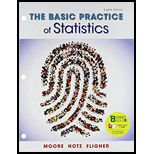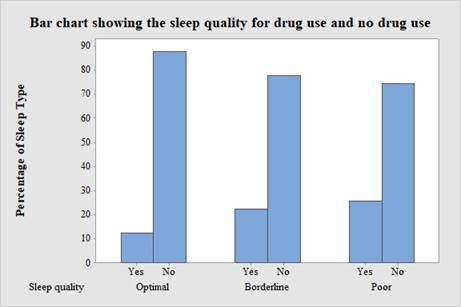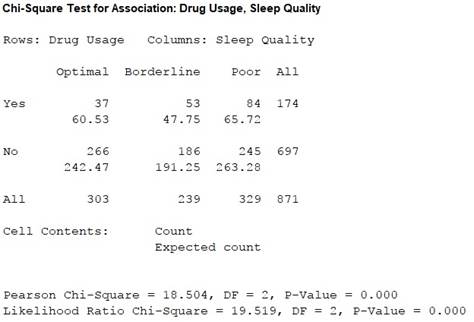
a.
To construct: The 95% confidence interval for the proportion of students who have used drugs more than one time in a given month to stay awake.
a.
Answer to Problem 25.33E
The 95% confidence interval for the proportion of students who have used drugs more than one time in a given month to stay awake is 0.173695 to 0.227894.
Explanation of Solution
Given info:
The data shows the association between the sleep quality classification and the use of over-the-counter (OTC) or prescription (RX) stimulant medication more than once a month to help keep them awake.
Calculation:
Let
Thus, the proportion of students who have used drugs more than one time in a given month to stay awake is 0.1998.
Software procedure:
Step-by-step procedure for constructing 95% confidence interval for the given proportion is shown below:
- Click on Stat, Basic statistics and 1-proportion.
- Choose Summarized data, under Number of
events enter 174, under Number of trials enter 871. - Click on options, choose 95% confidence interval.
- Click ok.
Output using MINITAB is given below:

Conclusion:
The 95% confidence interval for the proportion of students who have used drugs more than one time in a given month to stay awake is 0.173695 to 0.227894.
b.
To find: The conditional distribution for the sleep quality of the students who have used drugs and those who haven’t.
To construct: A graph that compares the two conditional distributions.
To describe: The relationship between the students who have used drugs to stay awake and students who haven’t used drugs to stay awake.
b.
Answer to Problem 25.33E
The conditional distribution for the sleep quality of the students who have used the drugs and those who haven’t used the drugs is given below:
| Sleep Quality | Conditional distributionof sleep quality for students who have used drugs | Conditional distribution of sleep quality for students who haven’t used drugs |
| Optimal | 12.2 | 87.8 |
| Borderline | 22.2 | 77.8 |
| Poor | 25.5 | 74.5 |
Output obtained from MINITAB is given below:

The students who have consumed drugs have less amount of optimal sleep than students who haven’t consumed drugs. Thus, consuming drugs helps the students to stay awake.
Explanation of Solution
Calculation:
The conditional distribution for the sleep quality of the students who have used the drugs is calculated as follows:
The conditional distribution for the sleep quality of the students who haven’t used the drugs is calculated as follows:
The two conditional distributions are given below:
| Sleep Quality | Conditional distributionof sleep quality for students who have used drugs | Conditional distribution of sleep quality for students who haven’t used drugs |
| Optimal | ||
| Borderline | ||
| Poor |
Software procedure:
Step-by-step procedure for constructing a bar graph for comparing the two conditional distributions is given below:
- Click on Graph, select Bar Chart.
- Under Bar represent: select Values from table.
- In Two-way table select Cluster and then click ok.
- In Graph variables, enter the columns of Yes and No.
- In Row labels, select Sleep quality.
- Under Table Arrangement, select Rows are outermost categories and columns are innermost.
- Click ok.
Interpretation:
The bar graph is constructed for the conditional distributions of sleep quality for students who have used drugs and students who haven’t used the drugs.
The bars are separated into three sets; the bars to the leftmost side represent the “Optimal” sleep quality, the bars placed in the middle represent the “Borderline” sleep quality, and the bars placed to the rightmost side represent the “Poor” sleep quality.
Justification:
From the conditional distributions and the bar graph, it can be observed that students who have consumed drugs have less amount of optimal sleep than students who haven’t consumed drugs.
Thus, consuming drugs help the students to stay awake.
c.
To test: Whether students who use drugs more than one time in a month to stay awake have a difference in sleep quality than the students who don’t use drugs.
To state: The hypotheses used for testing.
To give: The P-value and the conclusion.
c.
Answer to Problem 25.33E
There is a significant difference in the sleep quality between the students who have used the drugs and the students who don’t use drugs.
The hypotheses used for testing is given below:
The P-value is 0.000.
The drugs help the students to stay awake.
Explanation of Solution
Calculation:
The claim is to test whether there is any significant difference between the sleep quality of the students who have used the drugs and students who haven’t used the drugs.
Cell frequency for using Chi-square test:
- When at most 20% of the cell frequencies are less than 5
- If all the individual frequencies are 1 or more than 1.
- All the expected frequencies must be 5 or greater than 5.
The hypotheses used for testing is given below:
Software procedure:
Step-by-step procedure for calculating the chi-square test statistic is given below:
- Click on Stat, select Tables and then click on Chi-square Test of Association.
- Select Summarized data in a two-way table.
- Under Columns containing the table: enter the columns of Optimal, Borderline and Poor.
- Under Labels for the table (optional), select Drug Usage in the Rows: box and type Sleep Quality for the Column category name.
- Under statistics, click on Chi-square test.
- Click on ok.
Output obtained from MINITAB is given below:

Thus, the test statistic is 18.504 and the P-value is 0.000.
Since all the expected frequencies are greater than 5,the usage of chi-square test is appropriate.
Conclusion:
The P-value is 0.000 and the level of significance is 0.05.
Here, the P-value is lesser than the level of significance.
Therefore, the null hypothesis is rejected.
Thus, there is strong evidence that there is a relationship between the sleep quality and drug usage.
Hence, students who have used the drugs have a low level of optimal sleep thanthe students who didn’t use the drugs. Thus, drugs help the students to stay awake.
Want to see more full solutions like this?
Chapter 25 Solutions
BASIC PRACTICE OF STATS-LL W/SAPLINGPLU
- ons 12. A sociologist hypothesizes that the crime rate is higher in areas with higher poverty rate and lower median income. She col- lects data on the crime rate (crimes per 100,000 residents), the poverty rate (in %), and the median income (in $1,000s) from 41 New England cities. A portion of the regression results is shown in the following table. Standard Coefficients error t stat p-value Intercept -301.62 549.71 -0.55 0.5864 Poverty 53.16 14.22 3.74 0.0006 Income 4.95 8.26 0.60 0.5526 a. b. Are the signs as expected on the slope coefficients? Predict the crime rate in an area with a poverty rate of 20% and a median income of $50,000. 3. Using data from 50 workarrow_forward2. The owner of several used-car dealerships believes that the selling price of a used car can best be predicted using the car's age. He uses data on the recent selling price (in $) and age of 20 used sedans to estimate Price = Po + B₁Age + ε. A portion of the regression results is shown in the accompanying table. Standard Coefficients Intercept 21187.94 Error 733.42 t Stat p-value 28.89 1.56E-16 Age -1208.25 128.95 -9.37 2.41E-08 a. What is the estimate for B₁? Interpret this value. b. What is the sample regression equation? C. Predict the selling price of a 5-year-old sedan.arrow_forwardian income of $50,000. erty rate of 13. Using data from 50 workers, a researcher estimates Wage = Bo+B,Education + B₂Experience + B3Age+e, where Wage is the hourly wage rate and Education, Experience, and Age are the years of higher education, the years of experience, and the age of the worker, respectively. A portion of the regression results is shown in the following table. ni ogolloo bash 1 Standard Coefficients error t stat p-value Intercept 7.87 4.09 1.93 0.0603 Education 1.44 0.34 4.24 0.0001 Experience 0.45 0.14 3.16 0.0028 Age -0.01 0.08 -0.14 0.8920 a. Interpret the estimated coefficients for Education and Experience. b. Predict the hourly wage rate for a 30-year-old worker with four years of higher education and three years of experience.arrow_forward
- 1. If a firm spends more on advertising, is it likely to increase sales? Data on annual sales (in $100,000s) and advertising expenditures (in $10,000s) were collected for 20 firms in order to estimate the model Sales = Po + B₁Advertising + ε. A portion of the regression results is shown in the accompanying table. Intercept Advertising Standard Coefficients Error t Stat p-value -7.42 1.46 -5.09 7.66E-05 0.42 0.05 8.70 7.26E-08 a. Interpret the estimated slope coefficient. b. What is the sample regression equation? C. Predict the sales for a firm that spends $500,000 annually on advertising.arrow_forwardCan you help me solve problem 38 with steps im stuck.arrow_forwardHow do the samples hold up to the efficiency test? What percentages of the samples pass or fail the test? What would be the likelihood of having the following specific number of efficiency test failures in the next 300 processors tested? 1 failures, 5 failures, 10 failures and 20 failures.arrow_forward
- The battery temperatures are a major concern for us. Can you analyze and describe the sample data? What are the average and median temperatures? How much variability is there in the temperatures? Is there anything that stands out? Our engineers’ assumption is that the temperature data is normally distributed. If that is the case, what would be the likelihood that the Safety Zone temperature will exceed 5.15 degrees? What is the probability that the Safety Zone temperature will be less than 4.65 degrees? What is the actual percentage of samples that exceed 5.25 degrees or are less than 4.75 degrees? Is the manufacturing process producing units with stable Safety Zone temperatures? Can you check if there are any apparent changes in the temperature pattern? Are there any outliers? A closer look at the Z-scores should help you in this regard.arrow_forwardNeed help pleasearrow_forwardPlease conduct a step by step of these statistical tests on separate sheets of Microsoft Excel. If the calculations in Microsoft Excel are incorrect, the null and alternative hypotheses, as well as the conclusions drawn from them, will be meaningless and will not receive any points. 4. One-Way ANOVA: Analyze the customer satisfaction scores across four different product categories to determine if there is a significant difference in means. (Hints: The null can be about maintaining status-quo or no difference among groups) H0 = H1=arrow_forward
- Please conduct a step by step of these statistical tests on separate sheets of Microsoft Excel. If the calculations in Microsoft Excel are incorrect, the null and alternative hypotheses, as well as the conclusions drawn from them, will be meaningless and will not receive any points 2. Two-Sample T-Test: Compare the average sales revenue of two different regions to determine if there is a significant difference. (Hints: The null can be about maintaining status-quo or no difference among groups; if alternative hypothesis is non-directional use the two-tailed p-value from excel file to make a decision about rejecting or not rejecting null) H0 = H1=arrow_forwardPlease conduct a step by step of these statistical tests on separate sheets of Microsoft Excel. If the calculations in Microsoft Excel are incorrect, the null and alternative hypotheses, as well as the conclusions drawn from them, will be meaningless and will not receive any points 3. Paired T-Test: A company implemented a training program to improve employee performance. To evaluate the effectiveness of the program, the company recorded the test scores of 25 employees before and after the training. Determine if the training program is effective in terms of scores of participants before and after the training. (Hints: The null can be about maintaining status-quo or no difference among groups; if alternative hypothesis is non-directional, use the two-tailed p-value from excel file to make a decision about rejecting or not rejecting the null) H0 = H1= Conclusion:arrow_forwardPlease conduct a step by step of these statistical tests on separate sheets of Microsoft Excel. If the calculations in Microsoft Excel are incorrect, the null and alternative hypotheses, as well as the conclusions drawn from them, will be meaningless and will not receive any points. The data for the following questions is provided in Microsoft Excel file on 4 separate sheets. Please conduct these statistical tests on separate sheets of Microsoft Excel. If the calculations in Microsoft Excel are incorrect, the null and alternative hypotheses, as well as the conclusions drawn from them, will be meaningless and will not receive any points. 1. One Sample T-Test: Determine whether the average satisfaction rating of customers for a product is significantly different from a hypothetical mean of 75. (Hints: The null can be about maintaining status-quo or no difference; If your alternative hypothesis is non-directional (e.g., μ≠75), you should use the two-tailed p-value from excel file to…arrow_forward
 MATLAB: An Introduction with ApplicationsStatisticsISBN:9781119256830Author:Amos GilatPublisher:John Wiley & Sons Inc
MATLAB: An Introduction with ApplicationsStatisticsISBN:9781119256830Author:Amos GilatPublisher:John Wiley & Sons Inc Probability and Statistics for Engineering and th...StatisticsISBN:9781305251809Author:Jay L. DevorePublisher:Cengage Learning
Probability and Statistics for Engineering and th...StatisticsISBN:9781305251809Author:Jay L. DevorePublisher:Cengage Learning Statistics for The Behavioral Sciences (MindTap C...StatisticsISBN:9781305504912Author:Frederick J Gravetter, Larry B. WallnauPublisher:Cengage Learning
Statistics for The Behavioral Sciences (MindTap C...StatisticsISBN:9781305504912Author:Frederick J Gravetter, Larry B. WallnauPublisher:Cengage Learning Elementary Statistics: Picturing the World (7th E...StatisticsISBN:9780134683416Author:Ron Larson, Betsy FarberPublisher:PEARSON
Elementary Statistics: Picturing the World (7th E...StatisticsISBN:9780134683416Author:Ron Larson, Betsy FarberPublisher:PEARSON The Basic Practice of StatisticsStatisticsISBN:9781319042578Author:David S. Moore, William I. Notz, Michael A. FlignerPublisher:W. H. Freeman
The Basic Practice of StatisticsStatisticsISBN:9781319042578Author:David S. Moore, William I. Notz, Michael A. FlignerPublisher:W. H. Freeman Introduction to the Practice of StatisticsStatisticsISBN:9781319013387Author:David S. Moore, George P. McCabe, Bruce A. CraigPublisher:W. H. Freeman
Introduction to the Practice of StatisticsStatisticsISBN:9781319013387Author:David S. Moore, George P. McCabe, Bruce A. CraigPublisher:W. H. Freeman





